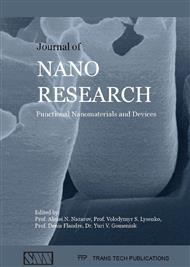[1]
K. Gopalakrishnan, P. A. Griffin, and J. D. Plummer, I-MOS a Novel Semiconductor Device with a Subthreshold Slope lower than kT/q, in International Electron Devices Meeting (IEDM2002), Technical Digest, 2002, pp.289-292.
DOI: 10.1109/iedm.2002.1175835
Google Scholar
[2]
H. Kam, D. T. Lee, R. T. Howe, and T. -J. King, A new Nano-Electromechanical Field-Effect Transistor (NEMFET) Design for Low-Power Electronics, in International Electron Devices Meeting (IEDM-2005), Technical Digest, 2005, pp.477-480.
DOI: 10.1109/iedm.2005.1609380
Google Scholar
[3]
N. Abelé, R. Fritschi, K. Boucart, F. Casset, P. Ancey, and A. M. Ionescu, Suspended-Gate MOSFET; bringing new MEMS functionality into solid-state mos transistor, in International Electron Devices Meeting (IEDM-2005), Technical Digest, 2005, pp.1075-1077.
DOI: 10.1109/iedm.2005.1609384
Google Scholar
[4]
S. Salahuddin and S. Datta, Use of Negative Capacitance to Provide Voltage Amplification for Low Power Nanoscale Devices, Nano Letts., vol. 8, no. 2, pp.405-410, July (2008).
DOI: 10.1021/nl071804g
Google Scholar
[5]
A.M. Ionescu, and H. Riel, Tunnel field-effect transistors as energy-efficient electronic switches, Nature, 479, (2011) pp.329-337.
DOI: 10.1038/nature10679
Google Scholar
[6]
E. Gnani, S. Reggiani, A. Gnudi, G. Baccarani, Steep-slope nanowire FET with a superlattice in the source extension,, Solid-State Electronics, vol. 65, (2011) pp.108-113.
DOI: 10.1016/j.sse.2011.06.008
Google Scholar
[7]
E. Gnani, P. Maiorano, S. Reggiani, A. Gnudi, G. Baccarani, Performance limits of superlatticebased steep-slope nanowire FETs, in emphInternational Electron Devices Meeting (IEDM-2005), Technical Digest, 2011, p.5. 1. 1-5. 1. 4.
DOI: 10.1109/iedm.2011.6131491
Google Scholar
[8]
B. A. Foreman, Elimination of spurious solutions from eight-band k·p theory, Phys. Rev. B 56 (20) (1997) R12748-R12751.
DOI: 10.1103/physrevb.56.r12748
Google Scholar
[9]
R. Lake, G. Klimeck, R. C. Bowen, D. Jovanovic, Single and multiband modeling of quantum electron transport through layered semiconductor devices, J. Appl. Phys. 81 (12) (1997) 7845- 7869.
DOI: 10.1063/1.365394
Google Scholar
[10]
I. Vurgaftman, J. R. Meyer, Band parameters for III-V compound semiconductors and their alloys, J. Appl. Phys. 89 (11) (2001) 5815-5875.
DOI: 10.1063/1.1368156
Google Scholar
[11]
E. Gnani, A. Gnudi, S. Reggiani, and G. Baccarani, Drain-conductance optimization in nanowire TFETs by means of a physics-based analytical model, Solid-State Electron., 84, pp.96-102, (2013).
DOI: 10.1016/j.sse.2013.02.012
Google Scholar
[12]
A. Seabaugh and Q. Zhang, Low-Voltage Tunnel Transistors for Beyond CMOS Logic, Proc. of IEEE, 98, 12, pp.2095-2110 (2010).
DOI: 10.1109/jproc.2010.2070470
Google Scholar
[13]
S. Mookerjea, R. Krishnan, S. Datta, V. Narayanan, On Enhanced Miller Capacitance Effect in Interband Tunnel Transistors, IEEE Electron Device Letters 30 (10) (2009) 1102-1104.
DOI: 10.1109/led.2009.2028907
Google Scholar
[14]
Y. Yang, X. Tong, L. -T. Yang, P. -F. Guo, L. Fan, Y. -C. Yeo, Tunneling Field-Effect Transistor: Capacitance Components and Modeling, IEEE Electron Device Letters 31 (7) (2010) 752-754.
DOI: 10.1109/led.2010.2047240
Google Scholar
[15]
J. Zhuge, A. S. Verhulst, W. G. Vandenberghe, W. Dehaene, R. Huang, Y. Wang, G. Groeseneken, Digital-circuit analysis of short-gate tunnel FETs for low-voltage applications, Semiconductor Science and Technology 26 (8) (2011) 085001.
DOI: 10.1088/0268-1242/26/8/085001
Google Scholar
[16]
E. Gnani, E. Baravelli, A. Gnudi, S. Reggiani, G. Baccarani, Capacitance estimation for InAs Tunnel FETs by means of full-quantum k · p simulation, Solid State Electronics, vol. 108, pp.104-109, (2015).
DOI: 10.1016/j.sse.2014.12.005
Google Scholar
[17]
G. Zhou, R. Li, T. Vasen, M. Qi, S. Chae, Y. Lu, Q. Zhang, H. Zhu, J. -M. Kuo, T. Kosel, M. Wistey, P. Fay, A. Seabaugh, and H. Xing, Novel gate-recessed vertical InAs/GaSb TFETs with record high ION of 180 µA/µm at VDS = 0. 5 V, in emphInternational Electron Devices Meeting (IEDM-2005), Technical Digest, 2011, pp.777-780.
DOI: 10.1109/iedm.2012.6479154
Google Scholar
[18]
E. Baravelli, E. Gnani, A. Gnudi, S. Reggiani, and G. Baccarani, TFET Inverters With n-/pDevices on the Same Technology Platform for Low-Voltage/Low-Power Applications, IEEE Trans. Electron Devices, vol. 61, pp.473-478, (2014).
DOI: 10.1109/ted.2013.2294792
Google Scholar
[19]
E. Baravelli, E. Gnani, R. Grassi, A. Gnudi, S. Reggiani, and G. Baccarani, Optimization of nand p-type TFETs integrated on the same InAs/AlxGa1−xSb technology platform, IEEE Trans. Electron Devices, vol. 61, pp.178-185, (2014).
DOI: 10.1109/ted.2013.2289739
Google Scholar
[20]
S. Sinha, G. Yeric, V. Chandra, B. Cline, and Y. Cao, Exploring sub-20nm FinFET design with predictive technology models, in Proc. DAC, 2012, pp.283-288.
DOI: 10.1145/2228360.2228414
Google Scholar
[21]
Semiconductor Industry Association (SIA), The International Technology Roadmap for Semiconductors (ITRS), 2012. [Online]. Available: http: /www. itrs. net.
Google Scholar
[22]
P. Maiorano, E. Gnani, A. Gnudi, S. Reggiani, G. Baccarani, Design and optimization of impurity- and electrostatically-doped superlattice FETs to meet all the ITRS power targets at VDD = 0. 4 V, Solid-State Electronics, vol. 101, pp.70-78, (2014).
DOI: 10.1016/j.sse.2014.06.020
Google Scholar
[23]
E. Gnani, P. Maiorano, S. Reggiani, A. Gnudi and G. Baccarani, An Investigation on SteepSlope and Low-Power Nanowire FETs, in Proc. of the ESSDERC Conference, 2011, pp.289-292.
DOI: 10.1109/essderc.2011.6044175
Google Scholar
[24]
P. Maiorano, E. Gnani, A. Gnudi, S. Reggiani, G. Baccarani, Effects of Dit-induced degradation on InGaAs/InAlAs Nanowire Superlattice-FET using Al2O3 and HfO2/La2O3 as gate stacks, Proc. of the EUROSOI-ULIS Conference, pp.57-60, (2015).
DOI: 10.1109/ulis.2015.7063772
Google Scholar


